How to prune geraniums for lush bloom?
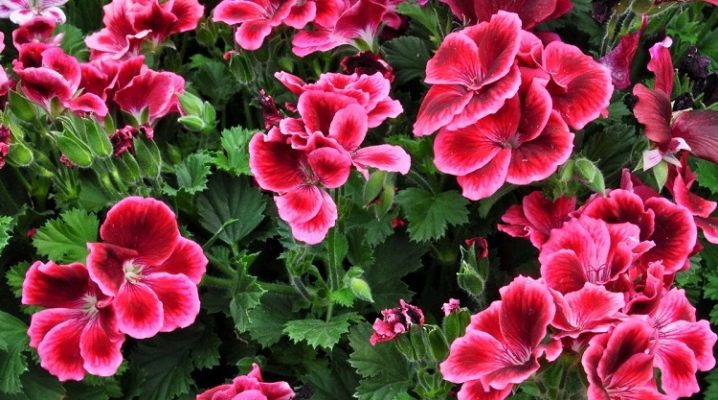
Geranium is a very common houseplant found on the windowsills of many apartments and houses. Its delicate color scheme is able to complement any room style. Florists show special interest in geranium, knowing about its unpretentiousness. But even the absence of a capricious character does not mean that the plant does not need proper care. An important step in keeping a room beauty is pruning. This procedure requires special attention from the owner of the plant, who wants to have a lush and flowering shrub.

Why do you need pruning?
Experienced flower growers and owners of large garden plots are quite often found with pelargonium, although for most people it is familiar as indoor geranium. In the botanical environment, pelargonium is classified as a geranium family, although it is a separate genus. Breeders say that geranium and pelargonium are synonymous words.
For every grower, plant pruning is a standard flower care routine. This action is designed to remove old stems and shorten long shoots. A well-performed procedure allows the plant to form new lush flower stalks, as well as acquire an incredibly beautiful shape.
If you neglect the pruning procedure, the leaves located at the bottom of the plant will fall off. The branches of the bush will be bare, and the flower itself will lose its natural beauty.
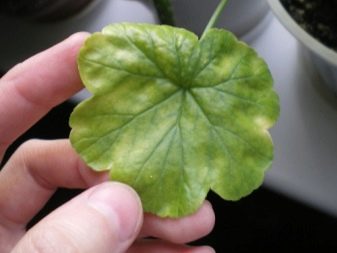
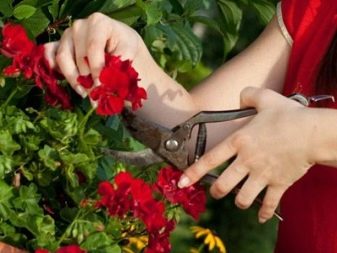
A distinctive feature of geranium is the presence of "dormant" buds, which are located in almost every nodal tie. Without human help, they are not able to sprout. Therefore, the pruning procedure will awaken the frozen buds, after which they can give young shoots.
In addition to the formation of peduncles and the growth of shoots, the pruning procedure has special concomitant effects:
- a timely performed procedure stimulates the plant for long and abundant flowering;
- the flower takes on an even miniature shape;
- the metabolic process is accelerated;
- timely pruning allows geraniums to feel better in winter;
- the plant has improved aeration, increased sensitivity to light;
- a well-performed pruning procedure is a preventive action in the event of diseases in a flower.
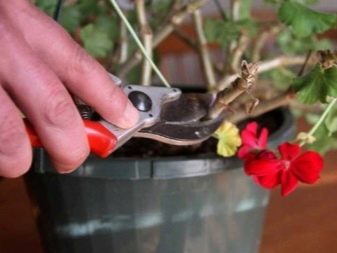
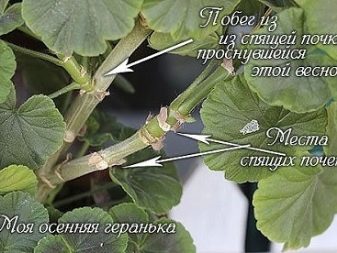
Carrying out the procedure for pruning geraniums, the florist will be able to get several planting materials in the form of young cuttings, which can later be grown into independent bushes.
Large geraniums after the pruning procedure will direct all available forces to growing new leaves and stems. For this reason, the inflorescences will appear too late or not at all. To avoid such a situation, the grower needs to shorten only diseased and elongated branches without leaves in large bushes.
In rare cases, the florist may not have time to carry out the pruning procedure, respectively, the bush will lose its neat appearance, and the young shoots will begin to resemble the stems of an adult flower. Pruning several cuttings from the top of the bush will help to correct the situation and rejuvenate the geranium.
In order for the geranium to be fluffy and grow thicker, the pruning procedure will have to be done several times a year.

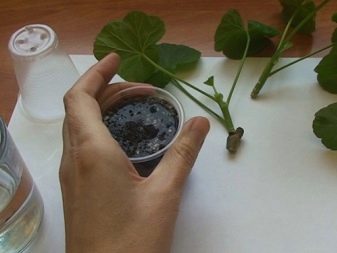
The right time
Pruning geraniums in the first place depends on the goal pursued by the florist.
- Spring, it is also the main one. The main goal of the procedure is to get a lush flower and form an even and neat bush shape. The procedure should be carried out immediately after the transition of the plant from the dormant period to the restoration of vitality. Most often this happens with the onset of the last week of February and until mid-March, more precisely, before the beginning of the growing season. After spring pruning, geranium begins to bloom a little later than nature suggests. However, the flowering period lasts much longer, and the size and number of flowers increases significantly.
- Autumn. This pruning procedure takes place after the geranium has faded. The procedure is carried out around the middle of autumn, preparing the flower for winter rest. Dried and yellowed leaves are cut from its top, which will subsequently affect the decorative form. The elongated parts of the stem are cut off in the area of the primary leaf node. If the grower wants the cut, elongated stem to bear fruit in the future, a cut must be made above the nodal bud. The main stem of the plant is shortened by one third.
- Topping. This procedure is done almost at any time of the year, except for the winter period, since with the onset of cold weather, the plant cannot be disturbed. Quite often, with the arrival of winter, due to a lack of light, the main stem of the geranium stretches in height. And this negatively affects the appearance of the plant. It is strictly forbidden to cut the elongated stem in the winter, since in the cold season the plant has a very negative attitude to such influences.
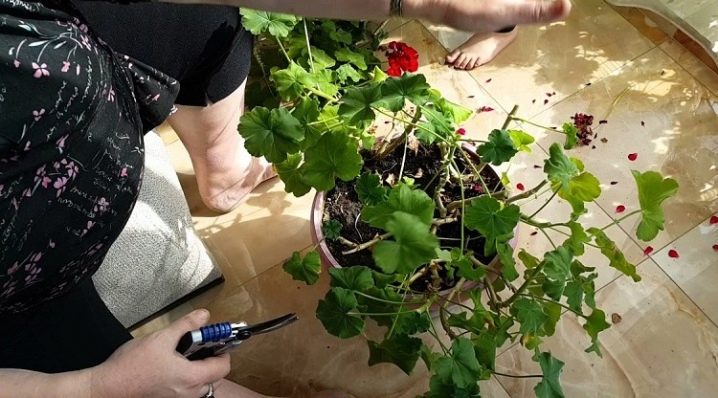
Inexperienced growers who have just introduced a few flowers into their garden claim that pinching or pruning geraniums can be done in January. Even despite the fact that the plant is indoor and accustomed to warm habitats, the winter months for it are a time of rest and sleep. And in the spring, the grower will need to start processing the bush.
It is best not to violate the timing of pruning geraniums, otherwise the plant will lose its shape, beauty and health.
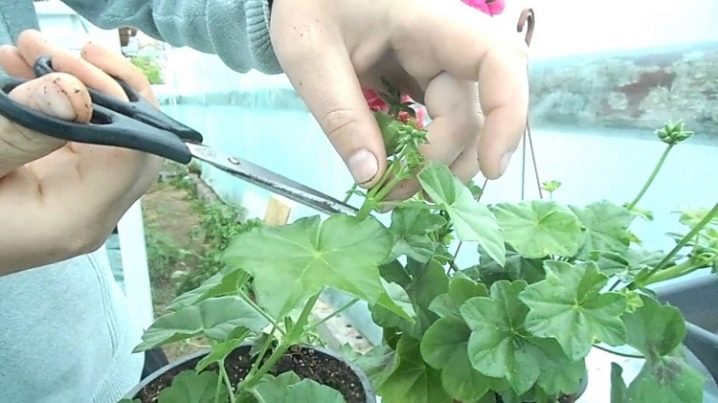
Step-by-step instruction
Geranium is an unpretentious plant, and yet requires some preparation before the pruning procedure. It seems to novice flower growers that it is extremely inconvenient to carry out such procedures at home. In fact, pruning a flower in an apartment is much easier than in a private house, since all the necessary accessories are at hand.
In addition to the flower itself, the equipment used undergoes a special preparation procedure.
- Geranium stems must be cleaned of yellowed and withered leaf plates.
- Pruning tools should be disinfected with boiling water, rubbing alcohol, or a special product purchased from a flower shop. The best for the procedure is a clerical knife with a thin and sharp blade. In this case, you should not use scissors, since the ends of the tool can damage the stem and disrupt the tissue structure of the plant.
To form a neat decorative shape, the geranium must be cut off immediately after planting. At the same time, do not forget to carry out the autumn and spring processing procedures, as well as pinch in a timely manner.
Breeders note that young shoots must be pinched to stimulate their growth.
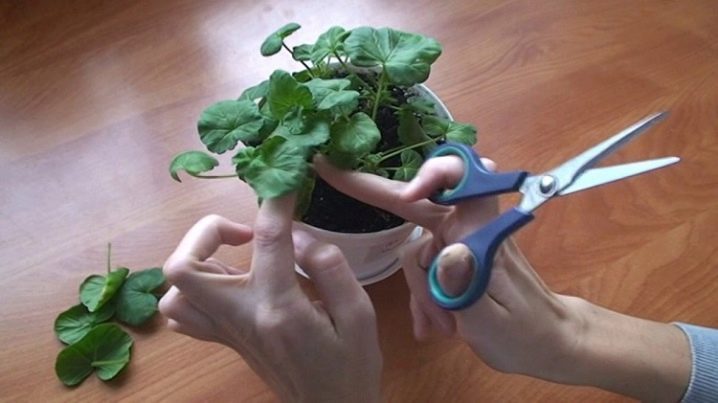
Further, it is proposed to familiarize yourself with the detailed pinching process, which allows you to form a decorative appearance:
- two weeks after planting, the upper bud must be pinned on a young shoot;
- the upper stems should be removed after three or four leafy nodes appear on them;
- to avoid the extensive thickets of leaves, the first step is to cut off the shoots growing inside the bush;
- after the bush has acquired the required shape, the pinching procedure should be stopped.
If the geranium has grown from a separate cutting, the plant should be pinched at the level of the tenth leaf.A young shoot, grown from a seed, is pinched at the level of the eighth leaf. Most importantly, remember that any kind of pruning must pursue a certain result, for example, getting a blooming ball. At the same time, stimulation of the lateral stems will not be enough; regular removal of branches that spoil the appearance and shape of the plant will be required.
You also need constant control over the top of the flower, if necessary, it is worth cutting off the shoots.

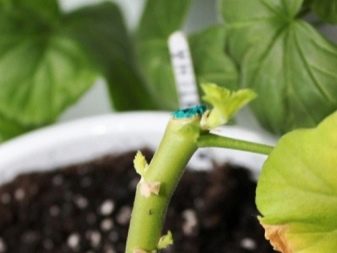
Having familiarized yourself with the pinching procedure and its features, you can proceed to the step-by-step study of the pruning instructions, the purpose of which is to get a lush flowering.
- To avoid the increased density and the emergence of new shoots, you will need to use a sharp tool and cut the stems over the leaf node, looking at the outside of the bush.
- So that the stalk does not turn out to be bare, the shoot is cut over the leaf plate.
- The stems growing inside the bush are carefully cut with a sharp blade.
- In order for the geranium to direct all its forces to the formation of the main stems, it is required to pinch the root part of the sprouts.
- The intertwined stems should be cut off. The same goes for diseased and bare processes.
- Healthy stems are cut at the level of the fifth leaf node.
- The main shoots are cut to one third of the total length.
- To prevent the cut plant from getting sick, the cut sites must be treated with a solution of activated carbon.
- After the pruning procedure, it is important to feed the geraniums with nitrogen-containing fertilizers.
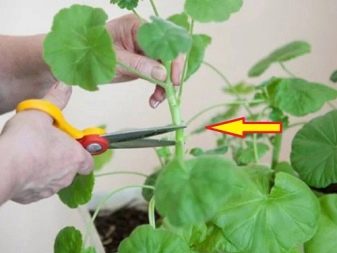
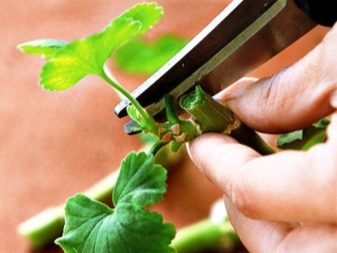
The pinching principle also helps to increase flowering and create a lush appearance. Although after several procedures, the bush can acquire an increased density and a very wide shape, which is very different from the desired one.
Experienced florists develop in advance schemes for the design of the decorative appearance of geraniums. Based on the idea, the plant is pinched, and the stems are cut according to the intended image.
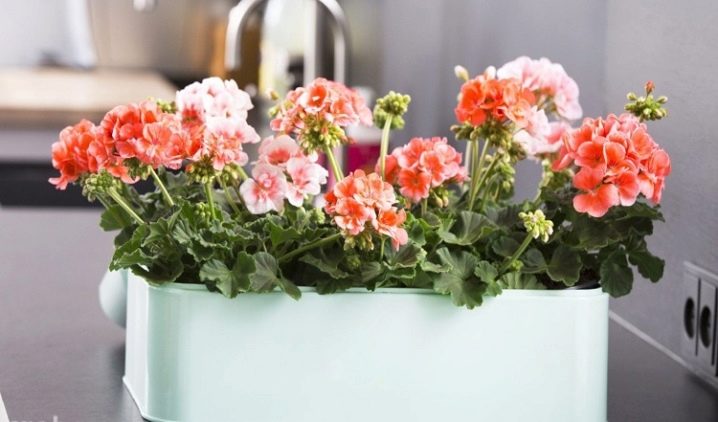
Further care
To consolidate the result, after the pruning procedure, geraniums must be moved to a cool room. The epicenter and cut areas must be treated with a special disinfectant and healing agent. In the absence of such, crushed activated carbon or cinnamon is used.
Cut geranium does not require special care and attention. It is enough to reduce the number of watering and spraying. Otherwise, the flower will not tolerate high humidity and will die. The lighting of the cut plant should be diffused. A flower that has just undergone cutting its stems wants to receive a small amount of sunlight, but not direct rays. In case of cloudy weather, the geranium should be placed under an artificial lamp.
After pruning, geraniums must be fed with fertilizers so that the plant gains strength and grows stronger.
Growers must know that spring pruning is stressful for geraniums. That is why, after the end of the procedure, the plant must be left alone, providing it with special care. The rest time for a cut flower is two weeks. During this period, the room where the pot of geraniums stands should have an acceptable flower temperature and humidity.
The room must be ventilated in a timely manner, otherwise the root system will begin to rot, and the flower itself will die.
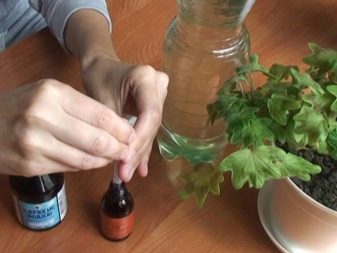
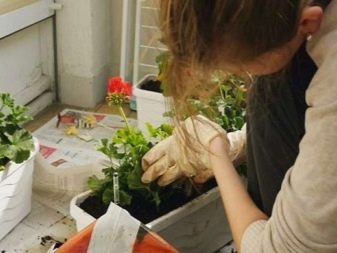
Frequent mistakes
The procedure for pruning geraniums is not difficult to perform. Subject to all the rules and step-by-step sequence, the result will exceed all expectations. However, novice gardeners who are faced with caring for geraniums for the first time may do the wrong thing, because of which the bush dies.

Below is a list of the most common mistakes often encountered when pruning geraniums.
- If the main part of the geranium's life takes place outdoors - on the balcony or on the window - before the autumn pruning, the flower should stand in the house for some time.The pruning procedure itself is considered significant stress for geraniums, and in addition to this, a sharp change in climate and environment. The flower must acclimatize after transferring the pot to the room, then after a couple of days it will steadily endure the prescribed procedures. Novice growers neglect this advice and immediately after bringing the flower into the room, they begin to cut it off. The consequences of a lack of human patience will be the yellowness of the flower, which is extremely difficult to cure.
- Before starting trimming, all instruments intended for the procedure must go through several stages of disinfection. After work, the cutting equipment also undergoes a special cleaning procedure. Every item related to floriculture should be dried before and after procedures. Ignoring this advice, the florist can introduce an infection into the cut wound of the geranium, after which the plant will get sick and may die.
- Almost all novice growers, having carried out the maximum pruning of geraniums in the autumn, put a pot with a flower on the window and increase the number of waterings several times, believing that the natural habitat will be able to evenly distribute moisture between the flower and the soil composition. The final result of these actions will be the decay of the geranium root system, in scientific terms, the plant will pick up the black leg disease. Watering the cut plant should be done infrequently and in small quantities. Excessive evaporation of moisture from the upper part of the soil layer should be excluded.
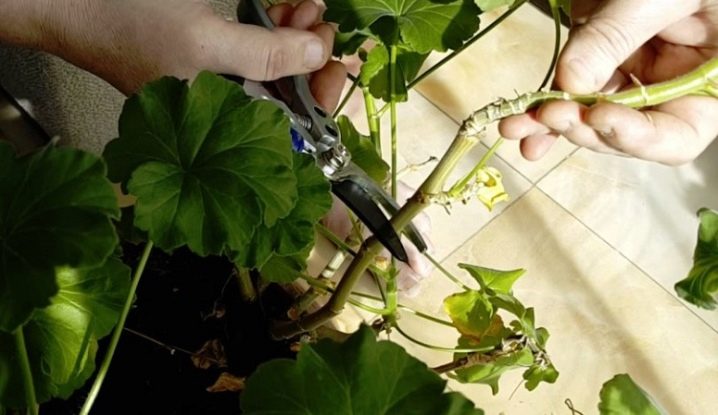
By listening to the prompts, any florist can grow the largest, most beautiful and dense geranium bush in his garden. And if the flower grows more than one, in the summer you can make a fabulous composition in the garden.
You can find out when and how to transplant geraniums correctly by watching the video below.







































































































The comment was sent successfully.